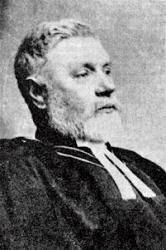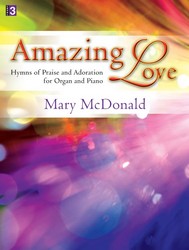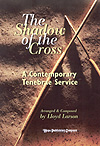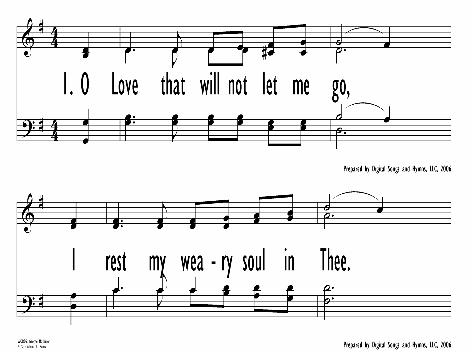- |
User Links
O Love That Wilt Not Let Me Go

O Love that wilt not let me go
Author: George Matheson (1882)Tune: ST. MARGARET (Peace)
Published in 718 hymnals
Printable scores: PDF, MusicXMLPlayable presentation: Lyrics only, lyrics + musicAudio files: MIDI, Recording
Representative Text
1. O love that will not let me go,
I rest my weary soul in thee;
I give thee back the life I owe,
That in thine ocean depths its flow
May richer, fuller be.
2. O Light that follows all my way,
I yield my flick'ring torch to thee;
My heart restores its borrowed ray,
That in thy sunshine's blaze its day
May brighter, fairer be.
3. O Joy that seekest me thru' pain,
I cannot close my heart to thee;
I trace the rainbow thru' the rain
And feel the promise is not vain
That morn shall tearless be.
4. O cross that liftest up my head,
I dare not ask to fly from thee;
I lay in dust life's glory dead,
And from the ground there blossoms red
Life that shall endless be.
Source: Hymns and Devotions for Daily Worship #240
Author: George Matheson
 Matheson, George, D.D., was born at Glasgow, March 27, 1842, and although deprived of his eyesight in youth he passed a brilliant course at the University of Edinburgh, where he graduated M.A. in 1862. In 1868 he became the parish minister at Innellan; and subsequently of St. Bernard's, Edinburgh. He was the Baird Lecturer in 1881, and St. Giles Lecturer in 1882. He has published several important prose works. His poetical pieces were collected and published in 1890 as Sacred Songs, Edinburgh: W. Blackwood. In addition to his hymn "O Love that wilt not let me go" (q. v.), four others from his Sacred Songs are in Dr. A. C. Murphey's Book of Common Song, Belfast, 1890.
--John Julian, Dictionary of Hymnology, Appendix, Part II (1907)… Go to person page >
Matheson, George, D.D., was born at Glasgow, March 27, 1842, and although deprived of his eyesight in youth he passed a brilliant course at the University of Edinburgh, where he graduated M.A. in 1862. In 1868 he became the parish minister at Innellan; and subsequently of St. Bernard's, Edinburgh. He was the Baird Lecturer in 1881, and St. Giles Lecturer in 1882. He has published several important prose works. His poetical pieces were collected and published in 1890 as Sacred Songs, Edinburgh: W. Blackwood. In addition to his hymn "O Love that wilt not let me go" (q. v.), four others from his Sacred Songs are in Dr. A. C. Murphey's Book of Common Song, Belfast, 1890.
--John Julian, Dictionary of Hymnology, Appendix, Part II (1907)… Go to person page >Text Information
Related Texts
| First Line: | O Love that wilt not let me go |
| Title: | O Love That Wilt Not Let Me Go |
| Author: | George Matheson (1882) |
| Meter: | 8.8.8.8.6 |
| Language: | English |
| Notes: | Spanish translation: See "Oh amor que no me dejarás" by Vicente Mendoza |
| Copyright: | Public Domain |
- (hymns)
- (hymns)
- (hymns)
- (hymns)
- (hymns)
- (hymns)
- (hymns)
- (hymns)
- (hymns)
- (hymns)
- (hymns)
- (hymns)
- (hymns)
- (hymns)
- (hymns)
- (hymns)
- (hymns)
- (hymns)
- (hymns)
- (hymns)
- (hymns)
- (hymns)
- (hymns)
- (hymns)
- (hymns)
- (hymns)
- (hymns)
- (hymns)
- (hymns)
- (hymns)
- (hymns)
- (hymns)
- (hymns)
- (hymns)
- (hymns)
- (hymns)
- (hymns)
- (hymns)
- (hymns)
- (hymns)
- (hymns)
- (hymns)
- (hymns)
- (hymns)
- (hymns)
- (hymns)
- (hymns)
- (hymns)
- (hymns)
- (hymns)
- (hymns)
- (hymns)
- (hymns)
- (hymns)
- (hymns)
- (hymns)
- (hymns)
- Year A, Lent, First Sunday
This is recommended for Year A, Lent, First Sunday by 2 hymnal lectionary indexes including Glory to God: the Presbyterian Hymnal #833 and Lift Up Your Hearts: psalms, hymns, and spiritual songs #457. - Year A, Lent, Third Sunday
This is recommended for Year A, Lent, Third Sunday by 2 hymnal lectionary indexes including Glory to God: the Presbyterian Hymnal #833. - Year A, Easter season, Easter Day
This is recommended for Year A, Easter season, Easter Day by 2 hymnal lectionary indexes including Glory to God: the Presbyterian Hymnal #833 and Lift Up Your Hearts: psalms, hymns, and spiritual songs #457. - Year A, Ordinary Time, Proper 6 (11)
This is recommended for Year A, Ordinary Time, Proper 6 (11) by 2 hymnal lectionary indexes including Glory to God: the Presbyterian Hymnal #833. - Year A, Ordinary Time, Proper 12 (17)
This is recommended for Year A, Ordinary Time, Proper 12 (17) by 4 hymnal lectionary indexes including Glory to God: the Presbyterian Hymnal #833 and Lift Up Your Hearts: psalms, hymns, and spiritual songs #457. - Year A, Ordinary Time, Proper 13 (18)
This is recommended for Year A, Ordinary Time, Proper 13 (18) by 2 hymnal lectionary indexes including Glory to God: the Presbyterian Hymnal #833. - Year A, Ordinary Time, Proper 13 (18)
- Year A, Ordinary Time, Proper 17 (22)
This is recommended for Year A, Ordinary Time, Proper 17 (22) by 2 hymnal lectionary indexes including Glory to God: the Presbyterian Hymnal #833 and Lift Up Your Hearts: psalms, hymns, and spiritual songs #457. - Year B, Lent, First Sunday
This is recommended for Year B, Lent, First Sunday by 2 hymnal lectionary indexes including Glory to God: the Presbyterian Hymnal #833 and Lift Up Your Hearts: psalms, hymns, and spiritual songs #457. - Year B, Lent, First Sunday
- Year B, Ordinary Time, Proper 9 (14)
This is recommended for Year B, Ordinary Time, Proper 9 (14) by 2 hymnal lectionary indexes including Glory to God: the Presbyterian Hymnal #833 and Lift Up Your Hearts: psalms, hymns, and spiritual songs #457. - Year C, Epiphany season, Fourth Sunday
This is recommended for Year C, Epiphany season, Fourth Sunday by 2 hymnal lectionary indexes including Glory to God: the Presbyterian Hymnal #833. - Year C, Easter season, Fifth Sunday
This is recommended for Year C, Easter season, Fifth Sunday by 2 hymnal lectionary indexes including Glory to God: the Presbyterian Hymnal #833. - Year C, Ordinary Time, Proper 20 (25)
This is recommended for Year C, Ordinary Time, Proper 20 (25) by 2 hymnal lectionary indexes.
Chinese
English
- A Hundred Songs of God and His Kingdom #d61
- A Hymnal for Friends #45
- A Hymnal for Joyous Youth: An all-purpose hymnal for church, young peoples' services and Sunday schools #40
- A Messenger for Jesus #d218
- A Selection of Hymns #d46
- A Service Hymn Book #d108
- A Treasury of Hymns: The best-loved hymns, carols, anthems, children's hymns, and gospel songs #164
- A. M. E. C. Hymnal #286
- A.M.E. Hymnal: with responsive scripture readings...(The Richard Allen A.M.E. Hymnal) #d282
- Abiding Songs: A special collection of standard hymns and gospel songs, long-cherished and forever abiding. Designed to generate wholesome, worshipful services of song among all organizations of ... #109 10 shown out of 571
French Creole
Korean
Spanish
Welsh
- Cân a Mawl: llyfr hymna a thonau Methodistiaid Calfinaidd Unol Dalaethau yr America=Song and Praise: the hymnal of the Calvinistic Methodist Church of the United States of America #221
- Mawl a chân = praise and song : llyfr hymnau a thonau i Gymru ar Wasgar = hymnal for Welsh and English church worship / crynhoad pwyllgor Eglwys Gymraeg, Detroit, Michigan #134
Yiddish
Notes
O Love that wilt not let me go. G. Matheson. [Jesus All and in All.] Dr. Matheson says this hymn was "written in the Manse of my former parish (Innellan, Argyleshire) one summer evening in 1882. It was composed with extreme rapidity; it seemed to me that its construction occupied only a few minutes, and I felt myself rather in the position of one who was being dictated to than of an original artist I was suffering from extreme mental distress, and the hymn was the fruit of pain." [L. MSS.] This hymn first appeared in the Church of Scotland magazine, Life and Work, in 1883 [sic 1882]. From thence it passed into the Scottish Hymnal 1884; and there set to special music by Dr. A. L. Peace. It is a beautiful and tender hymn and worthy of extensive use.
--John Julian, Dictionary of Hymnology, Appendix, Part II (1907)
Access an additional article on the Canterbury Dictionary of Hymnology:
Timeline
Arrangements
Media
The United Methodist Hymnal #480
- MIDI file from Awakening Songs for the Church, Sunday School and Evangelistic Services #137
- MIDI file from Baptist Hymnal 1991 #292
- MIDI file from Baptist Hymnal 1991 #292
- Audio recording from Baptist Hymnal 2008 #110
- MIDI file from The Cyber Hymnal #5160
- Audio recording from Glory to God: the Presbyterian Hymnal #833
- MIDI file from Make Christ King: a selection of high class gospel music for use in general worship and special evangelistic meetings #45
- Audio recording from Revival Hymns and Choruses #313
- MIDI file from Timeless Truths #392
- Audio recording from The Worshiping Church #531
- MIDI file from The United Methodist Hymnal #480
- Audio recording from The United Methodist Hymnal #480
- MIDI file from Worship and Rejoice #446


 My Starred Hymns
My Starred Hymns






